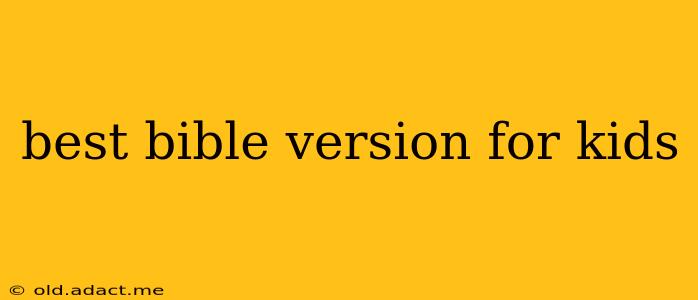Choosing the right Bible for your child can feel overwhelming. With so many versions available, each with its own style and language, it's important to find one that captures their attention and helps them understand the Bible's powerful messages. This guide will help you navigate the options and select the best Bible version for kids, considering age, reading level, and preferred storytelling style.
What Makes a Kid-Friendly Bible?
A great children's Bible goes beyond simply translating the text; it needs to engage young minds. Key features to look for include:
- Age-Appropriate Language: The language should be simple, clear, and easy to understand for the child's reading level. Avoid overly complex vocabulary or sentence structures.
- Engaging Storytelling: The stories should be told in a captivating way, using vivid language and perhaps incorporating elements like dialogue or descriptive imagery.
- Relevant Illustrations: High-quality illustrations are crucial for capturing a child's attention and helping them visualize the stories. Pictures should be vibrant, detailed, and accurately reflect the narrative.
- Thematic Organization: Some Bibles organize stories thematically, grouping related narratives together. This can be helpful for understanding overarching themes and concepts.
- Additional Features: Some children's Bibles include maps, timelines, or activity sections, adding extra value and engagement.
Which Bible Versions Are Best for Kids?
Several Bible versions are particularly well-suited for children. These are generally paraphrases or translations aimed at readability and understanding:
-
The Message: Known for its contemporary language, The Message Bible makes the stories accessible and engaging for children. However, it's a paraphrase, meaning it doesn't directly translate the original text word-for-word, which may be a consideration for some parents.
-
NIV (New International Version): The NIV is a popular choice for its accuracy and clarity. While not explicitly a children's Bible, many kid-friendly editions exist with illustrations and age-appropriate formatting. The language is generally straightforward, making it accessible to older elementary and middle school children.
-
NIRV (New International Reader's Version): Specifically designed for easier reading, the NIRV simplifies vocabulary and sentence structure, making it ideal for younger children.
-
Easy-to-Read Version (ERV): This version emphasizes simplicity and clarity, aiming to be easily understood by even beginning readers. It's excellent for younger children or those with reading difficulties.
H2: What about different age groups?
The best Bible version for a five-year-old will be drastically different from the best version for a twelve-year-old.
-
Preschool and Early Elementary (Ages 4-7): Look for Bibles with large print, colorful illustrations, and simple, easy-to-understand language. The ERV and NIRV are good options here, as are picture Bibles that focus on individual stories.
-
Late Elementary and Middle School (Ages 8-12): Children in this age group are capable of handling more complex sentences and vocabulary. The NIV, or a kid-friendly edition of other popular translations, becomes appropriate. Bibles with maps, timelines, or additional features can enhance their learning experience.
-
Teenagers (Ages 13+): Teenagers may prefer a standard translation like the NIV or ESV (English Standard Version), possibly with study notes or commentaries to help them grapple with more complex theological concepts.
H2: Are picture Bibles good for older kids?
While picture Bibles are excellent for younger children, they may not be as engaging for older kids. However, a well-illustrated Bible can still be helpful, even for older children, by providing visual aids and bringing the stories to life. Consider the overall style and quality of the illustrations when making your choice.
H2: Should I choose a paraphrase or a literal translation for my child?
This is a matter of personal preference. Paraphrases like The Message prioritize readability and accessibility, while literal translations like the ESV aim for greater accuracy to the original text. The best choice depends on your priorities and your child's age and reading level. For younger children, a paraphrase's clarity is often preferable. As children get older, they may benefit from a more literal translation to develop a more nuanced understanding of the text.
Ultimately, the best Bible version for kids is the one that captures their interest, aids their understanding, and inspires them to connect with the stories and messages of the Bible. Take your time, explore different versions, and choose the one that best suits your child's needs and your family's values.
